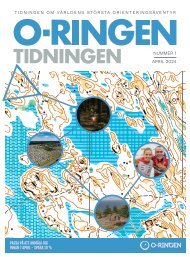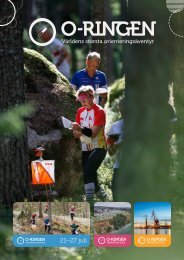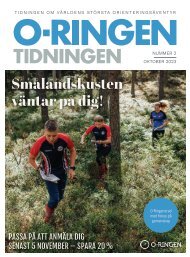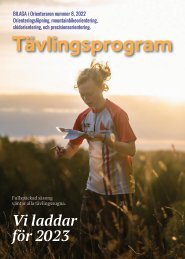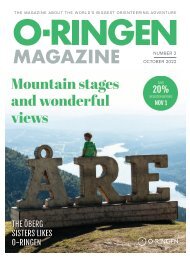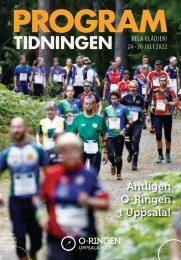O-Ringen Magazine, nr 1 2024
The worlds biggest orienteering adventure. Oskarshamn, Smålandskusten, July 21st to 27 th 2024.
The worlds biggest orienteering adventure. Oskarshamn, Smålandskusten, July 21st to 27 th 2024.
Create successful ePaper yourself
Turn your PDF publications into a flip-book with our unique Google optimized e-Paper software.
» Arena ROSENFORS<br />
STAGE 1 LONG DISTANCE<br />
Monday July 22 nd <strong>2024</strong><br />
STAGE 2 MIDDLE DISTANCE<br />
Tuesday July 23 rd <strong>2024</strong><br />
» Arena ROSENFORS<br />
The arena for stages 1 and 2 is on the edge of the small industrial community<br />
of Rosenfors. The village formed when Rosenfors AB was founded<br />
in 1802 and today it is a modern foundry with proud roots. The arena is<br />
also on the edge of the large and fertile Abyslätten plain and is normally<br />
used to grow potatoes. The fine, sandy soil gives plentiful harvests and<br />
you might think it will mean fast running for this stage. On the other side<br />
of the road, however, awaits a completely different type of terrain.<br />
STAGE 1<br />
LONG DISTANCE<br />
STAGE 2<br />
MIDDLE DISTANCE<br />
On Stage 1, the hills come almost immediately. First<br />
gently, but the further into the map you run, the more<br />
challenging they become. You’ll need to cross both large<br />
and small marshes, with lush vegetation and there are<br />
some craggy and rocky areas. It will be a tough start to<br />
the week for many runners..<br />
The terrain varies between fast and more technical areas and, for<br />
elite runners, there will be a real sense of wilderness furthest out<br />
in the forest. A small John Bauer-style lake almost takes you into a<br />
fairytale when you look down at it from one of the hills.<br />
Beautiful, mature pine forest with good visibility, though thick<br />
bilberry and lingonberry undergrowth will take its toll. There is a<br />
very limited path and track network, giving a great orienteering<br />
experience in beautiful Småland nature.<br />
Interview with course setter Marie Svalbring<br />
What can competitors expect from Stage 1? What’s special?<br />
– Stage 1 uses a large area, with a variety of terrain and runnability.<br />
There is also lots of variation between steeper and flatter areas. The<br />
southern part, where the easier courses go, has some paths and<br />
tracks. The northern part of the map has more of a wilderness feel.<br />
Beautiful hilltops alternate with idyllic marshes and tough, craggy<br />
areas. All runners will will get to choose routes through these<br />
lovely forests and each course has its own character,” says Marie<br />
Svalbring, one of the course setters for Stage 1.<br />
What is the most challenging aspect of this terrain?<br />
– The terrain is varied, which means you have to adapt your orienteering<br />
technique as you go. There are many features to use but<br />
the courses are still technically challenging. Some areas are tough<br />
to run on as there is a lot of wonderful bilberry vegetation in the<br />
forest, continues Marie.<br />
What’s your advice for orienteering well<br />
here and what should competitors be practising?<br />
– The open terrain on Stage 1 means that you will be able to see<br />
other competitors a lot of the time. However, there’s not much<br />
chance that they’re going to the same control as you, as there are so<br />
many controls in the area. So, success here will come from being<br />
focused on your own orienteering, being able to change pace and<br />
checking your control codes. Stage 1 won’t be an easy start to your<br />
O-<strong>Ringen</strong> week, concludes Marie.<br />
Stage 2 uses the same arena as Stage 1 but offers more<br />
technical terrain, perfect for middle distance. Just about<br />
all of this stage will take place on a large hill, which is<br />
itself covered by smaller hills and steep in parts. There<br />
are many boulders and crags, with tricky, detailed areas.<br />
As with Stage 1, runnability varies from good to limited.<br />
You’ll have to take care and avoid losing contact with the map.<br />
Re-entrants, small ravines, marshes and crags come one after the<br />
other and there will be many controls close together. This stage also<br />
offers great views for anyone happy to pause for a few seconds. Some<br />
of the hilltops have fantastic views across Emådalen and the home<br />
stadium of the Dackarna speedway team, which is just a stone’s<br />
throw away.<br />
Interview with course setter Joakim Karmetun<br />
What can competitors expect from Stage 2? What’s special?<br />
– Stage 2 takes place on a large hill, which is mostly very runnable.<br />
The area has almost no felled or developed areas and is almost<br />
exclusively steep, forested terrain with many boulders and crags.<br />
There aren’t many paths in the area and most courses will actually<br />
be in terrain with no paths. This means that you can enjoy the<br />
beautiful, open forest, which mostly has great visibility, says Joakim<br />
Karmetun, course setter for Stage 2.<br />
What is the most challenging aspect of this terrain?<br />
– Apart from the physical challenges offered by a hilly area with<br />
bilberry undergrowth, there are many orienteering challenges. For<br />
example, this is a rocky and craggy area. This means there is always<br />
a feature to use but, on the other hand, it’s easy to make parallel<br />
errors,” says Joakim.<br />
What’s your advice for orienteering well<br />
here and what should competitors be practising?<br />
– The open terrain on Stage 1 means that you will be able to see<br />
other competitors for much of the time. However, there’s not much<br />
chance that they’re going to the same control as you, as there are so<br />
many controls in the area.<br />
So, success here will come from being focused on your own orienteering,”<br />
says Joakim. “If you want to come really well prepared, train<br />
to run up and down hills. If you do that and also train to orienteer<br />
in detailed hillside areas, you’ve given yourself the best chance of<br />
success on Stage 2, he finishes.<br />
18 O-RINGEN MAGAZINE NO. 1 • <strong>2024</strong> O-RINGEN MAGAZINE NO. 1 • <strong>2024</strong> 19





